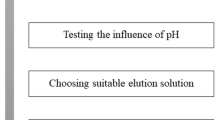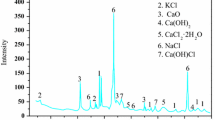Abstract
Cesium-137 is an important indicator of radioactive pollution in the aquatic environment. The aim of this study was to increase the sorption capacity of fly ash by its modification using hexacyanoferrate impregnation. According to the results, the Langmuir model was more likely to be correct than the Freundlich model. The maximum sorption capacity qmax was 1.59 mmol/g, i.e. 210 mg Cs+ per 1 g of the prepared sorbent. There was no significant decrease in the sorption capacity in the presence of both monovalent and divalent competitive cations. At the volume of 1–42 L the yield of Cs sorption was above 90%.






Similar content being viewed by others
References
Clearfield A (2010) Seizing the caesium. Nat Chem 2:161–162. https://doi.org/10.1038/nchem.567
Ashraf MA, Akib S, Maah MJ, Yusoff I, Balkhair KS (2014) Cesium-137: radio-chemistry, fate, and transport, remediation, and future concerns. Crit Rev Environ Sci Tech 44:1740–1793. https://doi.org/10.1080/10643389.2013.790753
Ahearne JF (1997) Radioactive waste: the size of the problem. Phys Today 50(6):24–29. https://doi.org/10.1063/1.881763
Behrens EA, Sylvester P, Clearfield A (1998) Assessment of a sodium nonatitanate and pharmacosiderite-type ion exchangers for strontium and cesium removal from DOE waste simulants. Environ Sci Technol 32:101–107. https://doi.org/10.1021/es9704794
Ahmaruzzaman M (2010) A review on the utilization of fly ash. Prog Energy Combust Sci 36:327–363. https://doi.org/10.1016/j.pecs.2009.11.003
Kaminski MD (2009) Physical properties of alumino-silicate waste form for cesium and strontium. J Nucl Mater 293:510–518. https://doi.org/10.1016/j.jnucmat.2009.04.020
Mimura H, Lehto J, Harjula R (1997) Selective removal of cesium from simulated high-level liquid wastes by insoluble ferrocyanides. J Nucl Sci Tech 34(6):607–609. https://doi.org/10.1080/18811248.1997.9733715
Iyer RS, Scott AJ (2001) Power station fly ash—a review of value-added utilization outside of the construction industry. Resour Conserv Recy 31:217–228. https://doi.org/10.1016/S0921-3449(00)00084-7
Shin JM, Park JJ, Song KC, Kim JH (2009) Trapping behavior of gaseous cesium by fly ash filters. Appl Radiat Isotopes 67:1534–1539. https://doi.org/10.1016/j.apradiso.2009.02.070
Li Q, Sun Z, Tao D, Xu Y, Li P, Cui H, Zhai J (2013) Immobilization of simulated radionuclide 133Cs+ by fly ash-based geopolymer. J Hazard Mater 262:325–331. https://doi.org/10.1016/j.jhazmat.2013.08.049
Li D, Kaplan DI, Knox AS, Crapse KP, Diprete DP (2014) Aqueous 99Tc, 129I and 137Cs removal from contaminated groundwater and sediments using highly effective low-cost sorbents. J Environ Radioact 136:56–63. https://doi.org/10.1016/j.jenvrad.2014.05.010
Apak R, Atun G, Güçlü K, Tütem E (1996) Sorptive removal of cesium-137 and strontium-90 from water by unconventional sorbents. II. Usage of coal fly ash. J Nucl Sci Tech 33(5):396–402. https://doi.org/10.3327/jnst.33.396
Mimura H, Yokota K, Akiba K, Onodera Y (2001) Alkali hydrothermal synthesis of zeolites from coal fly ash and their uptake properties of cesium ion. J Nucl Sci Tech 38(9):766–772. https://doi.org/10.1080/18811248.2001.9715093
Vrtoch Ľ, Pipíška M, Horník M, Augustín J, Lesný J (2011) Sorption of cesium from water solutions on potassium nickel hexacyanoferrate-modified Agaricus bisporus mushroom biomass. J Radioanal Nucl Chem 287:853–862. https://doi.org/10.1007/s10967-010-0837-5
Dulanská S, Zvachová S, Silliková V, Mátel Ľ, Šauša O, Maťko I (2018) Modified biosorbent wood-decay fungus fomes fomentarius for pre-concentration of 137Cs in water samples. J Radioanal Nucl Chem 318(3):2493–2500. https://doi.org/10.1007/s10967-018-6332-0
Kiener J, Limousy L, Jeguirim M, Le Meins JM, Hajjar-Garreau S, Bigoin G, Ghimbeu CM (2019) Activated carbon/transition metal (Ni, In, Cu) hexacyanoferrate nanocomposites for cesium adsorption. Materials 12:1253–1270. https://doi.org/10.3390/ma12081253
Kim Y, Kim KY, Kim S, Harbottle D, Lee JW (2017) Nanostructured potassium copper hexacyanoferrate-cellulose hydrogel for selective and rapid cesium adsorption. Chem Eng J 313:1042–1050. https://doi.org/10.1016/j.cej.2016.10.136
Loss-Neskovic C, Ayrault S, Badillo V, Jimenez B, Garnier E, Fedoroff M, Jones DJ, Merinov B (2004) Structure of copper-potassium hexacyanoferrate (II) and sorption mechanisms of cesium. J Solid State Chem 177:1817–1828. https://doi.org/10.1016/j.jssc.2004.01.018
ORIGIN Pro 9: Data Analysis and Graphing Software, OriginLab, Nothampton, 2012;
Pilson MEQ (2013) An introduction to the chemistry of the sea. Cambridge University Press, Cambridge
Vincent T, Vincent Ch, Guibal E (2015) Immobilization of metal hexacyanoferrate ion-exchangers for the synthesis of metal ion sorbents—a mini-review. Molecules 20:20582–20613. https://doi.org/10.3390/molecules201119718
Ayrault S, Jimenez B, Garnier E, Fedoroff M, Jones DJ, Loos-Neskovic C (1998) Sorption mechanisms of cesium on CuII2 FeII(CN)6 and CuIII3 [FeIII(CN)6]2 hexacyanoferrates and their relation to the crystalline structure. J Solid State Chem 141:475–485. https://doi.org/10.1006/jssc.1998.7997
Han F, Zhang GH, Gu P (2013) Adsorption and equilibrium modeling of cesium on copper ferrocyanide. J Radioanal Nucl Chem 295:369–377. https://doi.org/10.1007/s10967-012-1854-3
Ho YS, Mckay G (1997) Pseudo-second order model for sorption processes. Proc Biochem 34:451–465. https://doi.org/10.1016/S0032-9592(98)00112-5
Azizian S (2004) Kinetic models of sorption: a theoretical analysis. J Colloid Interfaces Sci 276:47–52. https://doi.org/10.1016/j.jcis.2004.03.04
Akaike H (1973) Information theory and an extension of the maximum likelihood principle. In: Petrov BN, Csáki F (eds) Proceedings of the second international symposium on information theory. Akademiai Kiado, Budapest, pp 267–281
Bozdogan H (1987) Model selection and Akaike’s information criterion (AIC): the general theory and its analytical extensions. Psychometrika 52:345–370. https://doi.org/10.1007/BF02294361
Burnham KP, Anderson DR (2004) Multimodel inference: understanding AIC and BIC in model selection. Sociol Methods Res 33:261–304. https://doi.org/10.1177/0049124104268644
Akaike H (1974) A new look at the statistical model identification. IEEE Trans Autom Control 19:716–723. https://doi.org/10.1109/TAC.1974.1100705
Jalali-Rad R, Ghafourian H, Asef Y, Dalir ST, Sahafipour MH, Gharanjik BM (2004) Biosorption of cesium by native and chemically modified biomass of marine algae: introduce the new biosorbents for biotechnology applications. J Hazard Mater B116:125–134. https://doi.org/10.1016/j.jhazmat.2004.08.022
Chung HK, Kim WH, Park J, Cho J, Jeong TY (2015) Application of Langmuir and Freundlich isotherms to predict adsorbate removal efficiency or required amount of adsorbent. J Ind Eng Chem 28:241–246. https://doi.org/10.1016/j.jiec.2015.02.021
Rajec P, Orechovska J, Novák I (2000) NIFSIL: new composite sorbent for cesium. J Radioanal Nucl Chem 245(2):317–321. https://doi.org/10.1023/A:1006758304650
Milonjić S, Bispo I, Fedoroff M, Loos-Neskovic C, Vidal-Madjar C (2002) Sorption of cesium on copper hexacyanoferrate/polymer/silica composites in batch and dynamic conditions. J Radioanal Nucl Chem 252(3):497–501. https://doi.org/10.1023/A:1015846502676
Mimura H, Masanori K, Kenichi A, Onodera Y (1999) Selective removal of cesium from radioactive waste solutions using insoluble ferrocyanide-loaded mordenites. In: WM’99 conference
Arief VO, Trilestari K, Sunarso J, Indraswati N, Ismadji S (2008) Recent Progress on biosorption of heavy metals from liquids using low cost biosorbents: characterization, biosorption parameters and mechanism studies. Clean 36:937–962. https://doi.org/10.1002/clen.200800167
Milyutin VV, Mikheev SV, Gelis VM, Kononenko OA (2009) Coprecipitation of microamounts of cesium with precipitates of transition metal ferrocyanides in alkaline solutions. Radiochemistry 51:295–297. https://doi.org/10.1134/S106636220903014X
Milyutin VV, Mikheev SV, Gelis VM, Kozlitin EA (2009) Sorption of cesium on ferrocyanide sorbents from highly saline solutions. Radiochemistry 51:298–300. https://doi.org/10.1134/S1066362209030151
Sharygin L, Muromskiy A, Kalyagina M, Borovkov S (2007) A granular inorganic cation-exchanger selective to cesium. J Nucl Sci Technol 44:767–773. https://doi.org/10.3327/jnst.44.767
Bellomo A (1970) Formation of copper(II), Zinc(II), silver(I) and lead(II) ferrocyanides. Talanta 17:1109–1114. https://doi.org/10.1016/0039-9140(70)80103-5
Acknowledgements
This work was supported by the grant of Comenius University No. UK-36-2019 and the project of the Slovak Research and Development Agency under the Contract No. APVV-17-0150. This research is a part of a dissertation theses at the Comenius University.
Author information
Authors and Affiliations
Corresponding author
Ethics declarations
Conflict of interest
The authors declare that they have no conflict of interest.
Additional information
Publisher's Note
Springer Nature remains neutral with regard to jurisdictional claims in published maps and institutional affiliations.
Rights and permissions
About this article
Cite this article
Silliková, V., Dulanská, S., Horník, M. et al. Impregnated fly ash sorbent for cesium-137 removal from water samples. J Radioanal Nucl Chem 324, 1225–1236 (2020). https://doi.org/10.1007/s10967-020-07132-6
Received:
Published:
Issue Date:
DOI: https://doi.org/10.1007/s10967-020-07132-6




